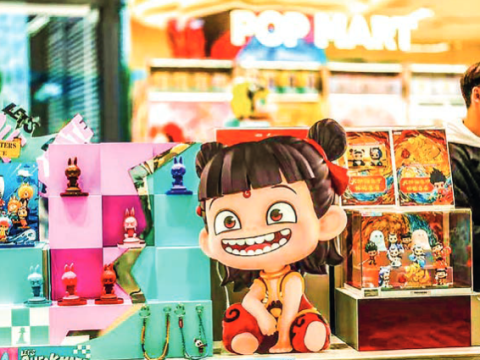ONCE deemed overshadowed by Japanese anime and US animation, Chinese animation is now experiencing a surge in popularity, especially among younger audiences.
With improved storytelling, advanced visual effects, and a seamless integration of traditional Chinese culture, the industry is rapidly gaining recognition at home and abroad.

ONCE deemed overshadowed by Japanese anime and US animation, Chinese animation is now experiencing a surge in popularity, especially among younger audiences.
With improved storytelling, advanced visual effects, and a seamless integration of traditional Chinese culture, the industry is rapidly gaining recognition at home and abroad.
A recent survey conducted by China Youth Daily among 7,232 university students revealed that 40.64 per cent actively follow popular domestic animation films and series, while 30.35 per cent check for new releases on a weekly basis.
This growing interest is reflected in the success of major box office hits, including “Ne Zha 2,” which grossed over 15.08 billion yuan (about US$2.1 billion) in box office revenue and stormed into the global box office top 5, cementing Chinese animation’s place in the global animation industry.
Most respondents attribute this rise to the ability of Chinese animated works to blend traditional cultural elements with modern cinematic techniques, which 81.1 per cent of surveyed students identified as a key factor in their interest.
Nearly 45 per cent believed that the technology used in Chinese animation is on par with international standards.
Recalling the release of “Chang An” and “Deep Sea”, both widely acclaimed Chinese animated films, Huang Ziyi, a student at Wuhan University, felt as if the poems from her textbooks had come to life. “The adaptations based on history were well-executed and felt authentic, bringing the audience closer to the stories.”
In recent years, driven by both technological advancements and a focus on Chinese cultural storytelling, the quality of Chinese animation has improved significantly. According to the survey, 67.78 per cent of university students shared this view.
“For instance, the movie ‘Chang An’ used AI to recreate the texture of Tang Dynasty architecture, providing a visual representation of poetic imagination. Meanwhile, ‘Ne Zha 2’ reinterpreted a classic myth through the lens of modern family dynamics, proving that technology should ultimately serve cultural expression,” said Chen Yanyu, a Jiangxi University of Technology student.
“I believe Chinese animation can carve out its own space in the industry,” Huang remarked. She noted that while Japanese anime often focuses on youthful romance and American animation emphasizes individual heroism, China has a vast pool of untapped storytelling potential. — Xinhua
Source: The Global New Light of Myanmar
ONCE deemed overshadowed by Japanese anime and US animation, Chinese animation is now experiencing a surge in popularity, especially among younger audiences.
With improved storytelling, advanced visual effects, and a seamless integration of traditional Chinese culture, the industry is rapidly gaining recognition at home and abroad.
A recent survey conducted by China Youth Daily among 7,232 university students revealed that 40.64 per cent actively follow popular domestic animation films and series, while 30.35 per cent check for new releases on a weekly basis.
This growing interest is reflected in the success of major box office hits, including “Ne Zha 2,” which grossed over 15.08 billion yuan (about US$2.1 billion) in box office revenue and stormed into the global box office top 5, cementing Chinese animation’s place in the global animation industry.
Most respondents attribute this rise to the ability of Chinese animated works to blend traditional cultural elements with modern cinematic techniques, which 81.1 per cent of surveyed students identified as a key factor in their interest.
Nearly 45 per cent believed that the technology used in Chinese animation is on par with international standards.
Recalling the release of “Chang An” and “Deep Sea”, both widely acclaimed Chinese animated films, Huang Ziyi, a student at Wuhan University, felt as if the poems from her textbooks had come to life. “The adaptations based on history were well-executed and felt authentic, bringing the audience closer to the stories.”
In recent years, driven by both technological advancements and a focus on Chinese cultural storytelling, the quality of Chinese animation has improved significantly. According to the survey, 67.78 per cent of university students shared this view.
“For instance, the movie ‘Chang An’ used AI to recreate the texture of Tang Dynasty architecture, providing a visual representation of poetic imagination. Meanwhile, ‘Ne Zha 2’ reinterpreted a classic myth through the lens of modern family dynamics, proving that technology should ultimately serve cultural expression,” said Chen Yanyu, a Jiangxi University of Technology student.
“I believe Chinese animation can carve out its own space in the industry,” Huang remarked. She noted that while Japanese anime often focuses on youthful romance and American animation emphasizes individual heroism, China has a vast pool of untapped storytelling potential. — Xinhua
Source: The Global New Light of Myanmar

THE Tokyo government has launched a new dating app for smartphones that uses artificial intelligence to match people who are serious about marriage based on their values.
Tokyo Enmusubi, meaning Tokyo matchmaking, is available for people over 18 who live in or commute to the Japanese capital. Users undergo an online interview upon registration, and they must also submit photo identification and documents proving their income and that they are legally single to ensure security on the platform.
THE Tokyo government has launched a new dating app for smartphones that uses artificial intelligence to match people who are serious about marriage based on their values.
Tokyo Enmusubi, meaning Tokyo matchmaking, is available for people over 18 who live in or commute to the Japanese capital. Users undergo an online interview upon registration, and they must also submit photo identification and documents proving their income and that they are legally single to ensure security on the platform.
The move is part of broader efforts to boost Japan’s declining birthrate, and the Tokyo metropolitan government aims to provide support to singles and families at various stages in their lives from the initial meeting to marriage, childbirth and child-rearing.
Users can download the app onto their smartphone or access the platform’s website via computer. Registration costs 11,000 yen ($77), and membership is valid for two years. —Kyodo
THE Tokyo government has launched a new dating app for smartphones that uses artificial intelligence to match people who are serious about marriage based on their values.
Tokyo Enmusubi, meaning Tokyo matchmaking, is available for people over 18 who live in or commute to the Japanese capital. Users undergo an online interview upon registration, and they must also submit photo identification and documents proving their income and that they are legally single to ensure security on the platform.
The move is part of broader efforts to boost Japan’s declining birthrate, and the Tokyo metropolitan government aims to provide support to singles and families at various stages in their lives from the initial meeting to marriage, childbirth and child-rearing.
Users can download the app onto their smartphone or access the platform’s website via computer. Registration costs 11,000 yen ($77), and membership is valid for two years. —Kyodo

